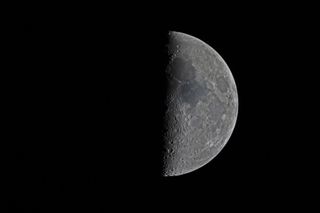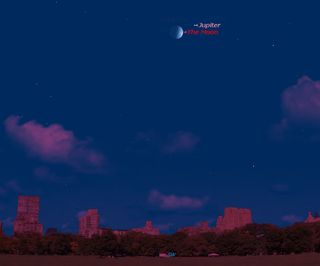
If the weather is clear on Saturday night (June 11), check out the western sky around mid-twilight to see Jupiter hovering close to the full moon.
About an hour after sunset, look to the west-southwest horizon and not quite halfway up to the overhead point, where you'll see an eye-catching sight: an almost-first-quarter moon, 47-percent illuminated, and a brilliant silvery white "star" hovering about 4 to 5 degrees to the right of the moon.
Of course, this isn't a star, but the planet named after the supreme sky god, Jupiter. To judge how far apart the moon and Jupiter will appear in the sky, recall that your clenched fist, held at arm's length, will measure about 10 degrees. ,, [Video: Jupiter's Moons, Saturn and a Comet in June's Night Sky]
Because they will be the two brightest objects in the sky, both the moon and Jupiter will likely attract the attention of even skywatchers who aren't looking for them. As the night progresses, the two celestial bodies will appear to descend in the sky, finally disappearing beyond the western horizon just after 1 a.m. local time. This is the last month in which our solar system's largest planet is high enough in a dark sky to permit crisp telescopic views of its cloud patterns and four big satellites.

Next to Venus, Jupiter is the brightest star-like object in the evening sky, and among the first bright objects to become visible each night at dusk. But for the rest of June and on into July, Jupiter will slowly slip farther down the horizon each night in the west-northwest. By the first week of August, it will be setting right around the time evening twilight ends. This month, Jupiter is falling far behind Earth in the never-ending planetary race around the sun, and Jupiter continues to move slowly eastward among the stars. Currently, it can be found in the zodiacal constellation of Leo, the lion. Because it takes nearly 12 years to orbit the sun, Jupiter spends about a year in each of the 12 zodiacal constellations. Jupiter moved into Leo in early June 2015 and will exit Leo and move into Virgo early in August 2016.
The real drama, however, will be getting underway a month from now. As you admire Jupiter and the moon on Saturday night, take note that, in mid-July, if you're really ambitious, you can try using binoculars to pick Venus out of the bright twilight only about 15 minutes after sunset. That is only the beginning of an agonizingly slow return of Venus to the evening sky for viewers at mid-northern latitudes, the start of its slow march into prominence as a grand "evening star" in late fall and winter. From mid-July onward, Venus and Jupiter will be slowly getting closer to each other; Jupiter will slowly go down in prominence as Venus comes up.
And on the evening of Aug. 27, Jupiter and Venus will appear exceptionally close together, being separated by just 4 arc minutes, or a mere 0.066 degree. That's much closer together than the apparent width of the moon — a real head turner that will likely attract considerable attention. Make a note on your calendar, and let's all hope for clear skies.
Get the Space.com Newsletter
Breaking space news, the latest updates on rocket launches, skywatching events and more!
Editor's note:If you snap an amazing photo of Jupiter and the moon and would like to share it with Space.com and our news partners for a possible story or image gallery, send images and comments to managing editor Tariq Malik at spacephotos@space.com.
Joe Rao serves as an instructor and guest lecturer at New York's Hayden Planetarium. He writes about astronomy for Natural History magazine, the Farmer's Almanac and other publications, and he is also an on-camera meteorologist for News 12 Westchester, New York. Follow us @Spacedotcom, Facebook or Google+. Originally published on Space.com.
Join our Space Forums to keep talking space on the latest missions, night sky and more! And if you have a news tip, correction or comment, let us know at: community@space.com.

Joe Rao is Space.com's skywatching columnist, as well as a veteran meteorologist and eclipse chaser who also serves as an instructor and guest lecturer at New York's Hayden Planetarium. He writes about astronomy for Natural History magazine, the Farmers' Almanac and other publications. Joe is an 8-time Emmy-nominated meteorologist who served the Putnam Valley region of New York for over 21 years. You can find him on Twitter and YouTube tracking lunar and solar eclipses, meteor showers and more. To find out Joe's latest project, visit him on Twitter.
